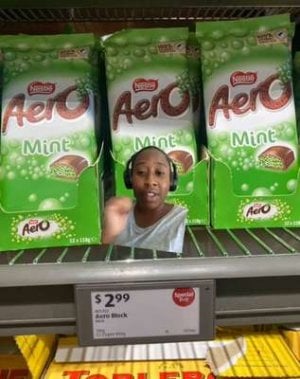ALDI customer reveals shocking price comparison with another supermarket
By
Danielle F.
- Replies 10
Savvy shoppers are always looking for the best deals, comparing prices to stretch their dollars further. After all, every penny saved is a small victory.
Sometimes, the price differences they uncover are nothing short of astonishing.
Recently, an eagle-eyed shopper took to social media to expose some 'wild' price discrepancies between items sold between two supermarkets.
‘If you live in Australia, we’re going to play a game of what the f**k, supermarket special,’ says Betty, who shared her findings in a video.
A 118g Nestle Aero Mint chocolate block, a sweet treat many enjoy with an afternoon cuppa, was priced at a modest $2.99 at ALDI.
In contrast, the same item at Woolworths was tagged at $4.50, discounted from a standard price of $6.
The differences do not stop there.
A 360g gift block of Toblerone, a popular choice for special occasions, was a staggering $16—now on special at $8—at Woolworths compared to ALDI's $7.99.
For those who love salty snacks, a Pringles Original 134g at Woolworths costs $5.50, while ALDI had them on the shelf for just $2.99.

Grocery costs can also fluctuate with weekly specials, with Woolworths trying to temporarily price-match ALDI on identical items.
Her findings resonated with many, with many leaving comments of dismay.
‘I used to love grocery shopping and now it’s an anxiety attack,’ one wrote.
‘This is wild,’ another read.
Queensland University of Technology Business School professor Gary Mortimer shed light on the bigger picture, explaining that the concept of 'economies of scale' plays a significant role in ALDI’s pricing strategy.
With over 10,000 stores globally, ALDI's bulk buying power dwarfs that of Woolworths and Coles, which have 1,400 and 800 supermarkets across Australia.
‘Accordingly, the manufacturer can sell the product at a lower unit price. This is passed on through lower retail prices to customers,’ he said.
Another factor that can lead to lower prices at stores such as ALDI and The Reject Shop is 'opportunistic procurement'.
When manufacturers overestimate demand and have excess stock, retailers can swoop in and negotiate rock-bottom prices for these surplus goods.
However, as Professor Mortimer points out, 'Once it's gone, it's gone,' meaning these deals are often fleeting.
Supermarkets also employ tactics like offering ‘exclusive products’, which despite their smaller size, still entices shoppers due to affordability.
With grocery bills being a hot topic during the current cost of living crisis, accusations of price gouging have been levelled at supermarkets, prompting the Australian Consumer and Competition Commission to conduct a year-long inquiry into the practice.
Despite praises for keeping items wallet-friendly, ALDI is not immune to criticism.
The retailer has been accused of 'shrinkflation', effectively absorbing increasing costs without raising prices.
Graham Cooke, head of consumer research at Finder, points out that ALDI's business model differs significantly from Woolworths and Coles.
ALDI offers fewer product lines and brands, focusing on lower prices, while Woolworths and Coles boast a vast variety of local and international products and brands.
Finder's research found that the price difference for a basket of 50 like-for-like products across the three leading supermarkets was relatively small, with ALDI at $200, Woolworths at $207, and Coles at $214.
In response to the uproar, Woolworths has since adjusted its prices on some of the items mentioned, offering the Toblerone for $8 and Pringles for $2.75 on special.
However, the Mint Aero blocks have returned to their original $6 price tag.

Have you noticed these price differences in your local supermarket? Tell us about it in the comments section below.
Sometimes, the price differences they uncover are nothing short of astonishing.
Recently, an eagle-eyed shopper took to social media to expose some 'wild' price discrepancies between items sold between two supermarkets.
‘If you live in Australia, we’re going to play a game of what the f**k, supermarket special,’ says Betty, who shared her findings in a video.
A 118g Nestle Aero Mint chocolate block, a sweet treat many enjoy with an afternoon cuppa, was priced at a modest $2.99 at ALDI.
In contrast, the same item at Woolworths was tagged at $4.50, discounted from a standard price of $6.
The differences do not stop there.
A 360g gift block of Toblerone, a popular choice for special occasions, was a staggering $16—now on special at $8—at Woolworths compared to ALDI's $7.99.
For those who love salty snacks, a Pringles Original 134g at Woolworths costs $5.50, while ALDI had them on the shelf for just $2.99.

A shopper found that commonly bought items have a staggering price difference between ALDI and Woolworths. Image Credit: TikTok/@bethblvk
Grocery costs can also fluctuate with weekly specials, with Woolworths trying to temporarily price-match ALDI on identical items.
Her findings resonated with many, with many leaving comments of dismay.
‘I used to love grocery shopping and now it’s an anxiety attack,’ one wrote.
‘This is wild,’ another read.
Queensland University of Technology Business School professor Gary Mortimer shed light on the bigger picture, explaining that the concept of 'economies of scale' plays a significant role in ALDI’s pricing strategy.
With over 10,000 stores globally, ALDI's bulk buying power dwarfs that of Woolworths and Coles, which have 1,400 and 800 supermarkets across Australia.
‘Accordingly, the manufacturer can sell the product at a lower unit price. This is passed on through lower retail prices to customers,’ he said.
Another factor that can lead to lower prices at stores such as ALDI and The Reject Shop is 'opportunistic procurement'.
When manufacturers overestimate demand and have excess stock, retailers can swoop in and negotiate rock-bottom prices for these surplus goods.
However, as Professor Mortimer points out, 'Once it's gone, it's gone,' meaning these deals are often fleeting.
Supermarkets also employ tactics like offering ‘exclusive products’, which despite their smaller size, still entices shoppers due to affordability.
With grocery bills being a hot topic during the current cost of living crisis, accusations of price gouging have been levelled at supermarkets, prompting the Australian Consumer and Competition Commission to conduct a year-long inquiry into the practice.
Despite praises for keeping items wallet-friendly, ALDI is not immune to criticism.
The retailer has been accused of 'shrinkflation', effectively absorbing increasing costs without raising prices.
Graham Cooke, head of consumer research at Finder, points out that ALDI's business model differs significantly from Woolworths and Coles.
ALDI offers fewer product lines and brands, focusing on lower prices, while Woolworths and Coles boast a vast variety of local and international products and brands.
Finder's research found that the price difference for a basket of 50 like-for-like products across the three leading supermarkets was relatively small, with ALDI at $200, Woolworths at $207, and Coles at $214.
In response to the uproar, Woolworths has since adjusted its prices on some of the items mentioned, offering the Toblerone for $8 and Pringles for $2.75 on special.
However, the Mint Aero blocks have returned to their original $6 price tag.
Key Takeaways
- Significant price differences between Woolworths and ALDI have been exposed by a shopper for some confectionery items, with ALDI offering lower prices.
- Woolworths has temporarily price-matched ALDI on certain products after the price discrepancies came to light.
- A professor cited economies of scale and global buying power as reasons for ALDI's lower pricing.
- Despite Woolworths and Coles rejecting price gouging claims, the Australian Consumer and Competition Commission has announced a year-long inquiry into the alleged practice. ALDI has also faced criticism for 'shrinkflation'.







